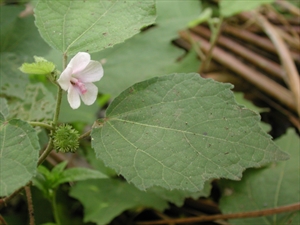- Widespread. Asia, Africa. North, South and Central America, Caribbean, Oceania. In most Pacific islands.
- Aggressive, invasive plant, fast-growing, capable of forming dense thickets. Able to grow in variety of soil types in forests, pastures, waste ground, swamps, waterways, roadsides, coastal dunes, plantations. Seeds easily spread.
- Erect, long-lived shrub, up to 2 m tall. Young stems green, with star-shaped hairs; older, woody. Leaves, alternate along the stems, up to 10 cm long. Lower leaves of variable shapes, uppermost smaller; all with toothed margins, pointed tips, and star-shaped hairs. Flowers, pink, 1.5-2 cm, single, with five reddish-pink petals, numerous stamens and branched style. Fruit, splits into five, 1-seeded segments, with hairs and spines.
- Spread: burrs, by animals; clothing; water; soil, produce, vehicles.
- Biosecurity: high risk of introductions on clothing. Noxious weed in Cuba, Fiji, USA.
- Biocontrol: little known.
- Cultural control: hand weeding; vehicle hygiene.
- Chemical control: in Australia: MCPA. In Fiji, glyphosate.






